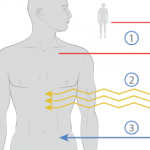To assess efficacy, the primary endpoint was a global rank composite score (GRCS) that ranked subjects based on a hierarchy of several important outcomes, including (in order) mortality, event-free survival (EFS) (without organ failure), lung function, scleroderma health assessment questionnaire and the modified Rodnan skin score.
At 54 months after randomization, the study found that in the intent-to-treat population, those undergoing stem cell transplantation had superior outcomes compared with the standard therapy group based on the GRCS. In the treated population, both overall survival and EFS were significantly improved after HSCT, supporting the primary finding. In addition, significantly fewer patients in the HSCT group had initiated disease-modifying anti-rheumatic drugs (DMARDs) at 54 months compared with the CYC group (9% vs 44%).
The study also found that serious adverse events were more frequent with HSCT and at 54 months. The overall mortality at 54 months was 9% in the HSCT arm compared with 24% in the CYC group. In the HSCT group, 3% of patients died of treatment-related causes. However, Dr. Sullivan emphasizes that the rates at study endpoint of treatment-related mortality and subsequent use of DMARDs were lower than those found in the ASTIS trial.
Talking to Patients
For Dr. Sullivan, these results strengthen the argument that practitioners should be talking to their patients about this treatment option. “Rheumatologists have two concerns,” he says: “Is this treatment approach safe, and are the improvements durable?” The results of the SCOT trial provide an affirmative answer to both, he says.
He advocates for rheumatologists to provide their patients with the needed information to make an informed decision by referring them to a center with expertise in the use of stem cell transplantation for scleroderma (see sidebar “Centers with Expertise in Scleroderma Research and Transplantation,” below).
Maureen D. Mayes, MD, professor of internal medicine, Elizabeth Bidgood Chair in Rheumatology, Division of Rheumatology and Clinical Immunogenetics, University of Texas McGovern Medical School, Houston, who works in one of these designated centers, emphasized the importance of speaking candidly to patients about the pros and cons of stem cell transplantation.
Acknowledging the positive results of the SCOT trial, she says stem cell transplantation is an option for patients with severe disease and a poor prognosis. However, she cautions that the positive results of the trial need to be balanced by the finding of a 3% treatment-related mortality.
This underscores the need to carefully select patients with a poor prognosis who are most likely to benefit from this treatment approach. “We’re looking at people with early diffuse skin disease who already have evidence of internal organ involvement,” she says.

